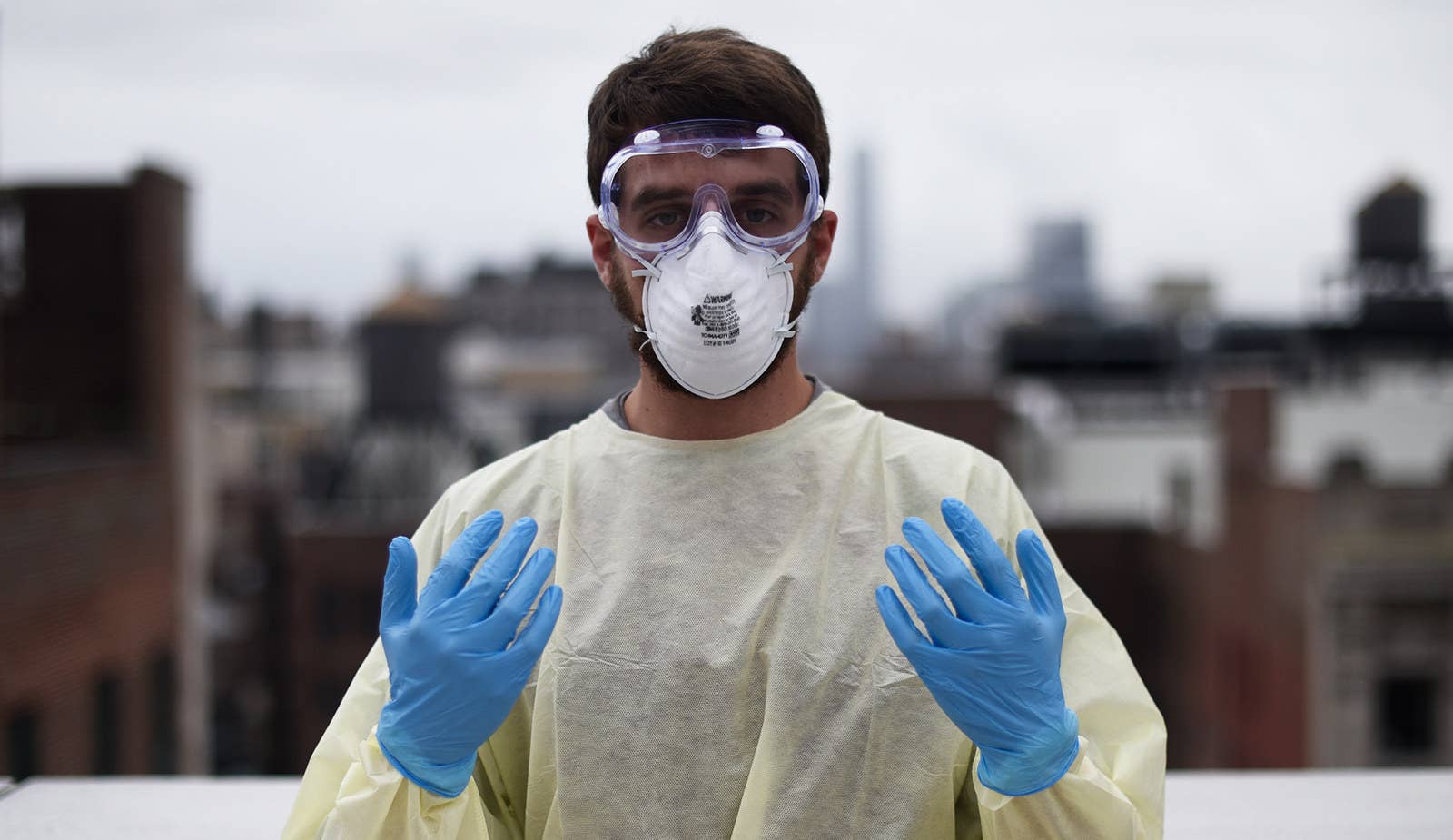
Without proven treatments or vaccines, our arsenal in the fight against Ebola consists of contact-tracing, decontamination, and prevention. Sealing off access to human bodies is our only battle-tested weapon, because you can’t get Ebola if you don’t touch Ebola.
For health care and burial workers in the “splash zone” — the area in which a person can get splashed with bodily fluids — recommended personal protective equipment (PPE) looks like a cartoon space suit. But aesthetics be damned; this level of protection seals out the wet danger of a hot zone with layer upon layer of waterproof materials. It’s the garb of choice for situations that slosh.
However, Ebola is not so easily transmitted via casual contact. Earlier this summer, Craig Manning, a spokesman for the U.S. Centers for Disease Control and Prevention (CDC), said that if he had a choice between being in a room with an Ebola patient or an influenza patient, he’d pick Ebola. His reasoning was that one can stay out of the splash zone, but it’s hard to avoid breathing in shared air. As such, workers who aren’t expected to encounter large quantities of infectious fluids wear streamlined PPE. And, with a little practice and attention to detail, it’s actually not that hard to do.
For example, when a flight from Newark had to be decontaminated after a passenger exhibited Ebola-like symptoms, the CDC guidelines for PPE were as follows: waterproof gloves (double-gloving recommended if cleaning large amounts of bodily fluids); surgical mask; eye goggles or a face shield; long-sleeved, waterproof gown; and rubber boots or shoe covers if there could be splashing. The goal is to protect all skin and mucous membranes from the cleaning chemicals in use, some of which could be hot with Ebola. This basic protective ensemble is also the minimum PPE recommended for hospital custodial and service personnel who are working outside the splash zone but in the vicinity of infected patients.
As important as the gear itself is the order in which you put it on and take it off. One must be vigilant to avoid the PPE version of panties-before-garter-belt, because sequence can literally make the difference between life and death.
Recently, the protocol has changed. Previously, the CDC’s general PPE poster said that goggles should be removed before the gown, but the CDC now recommends the gown come off prior to the goggles. The change gives more protection to the highly vulnerable eyes, nose, and mouth.
In addition, the CDC just added recommendations to wear a protective hood to cover the neck as well as fluid-resistant leg and feet coverings. These new recommendations appear to be aimed at people working in the splash zone and not those who are merely working nearby — although when asked directly on Thursday, the CDC did not say whether its new PPE guidelines applied to all PPE or just the type worn in the splash zone. An agency spokesperson said the CDC is reviewing its guidelines.
We will update this post as we learn more, but here are instructions on general — not splash-zone — PPE that were reviewed by the CDC on October 13.
Before you get started, please make sure that you have designated a safe place for PPE removal, a place for biohazardous waste collection, and a designated buddy to check your protective garb for loose ties or holes or other unseen calamities. It probably goes without saying that it should be someone you trust. Or you can just use a mirror.
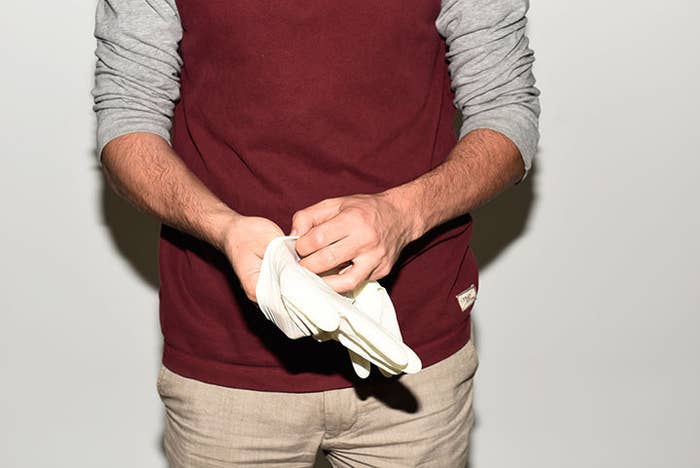
Now, go ahead and put on a pair of inner gloves, which we’re going to treat like your skin. These are your new bare hands; do not get them contaminated and do not be lulled into false complacency by their presence. They will remain on until the very end. Accept this as your new normal, and seriously, stop touching your face.
Ready? OK.
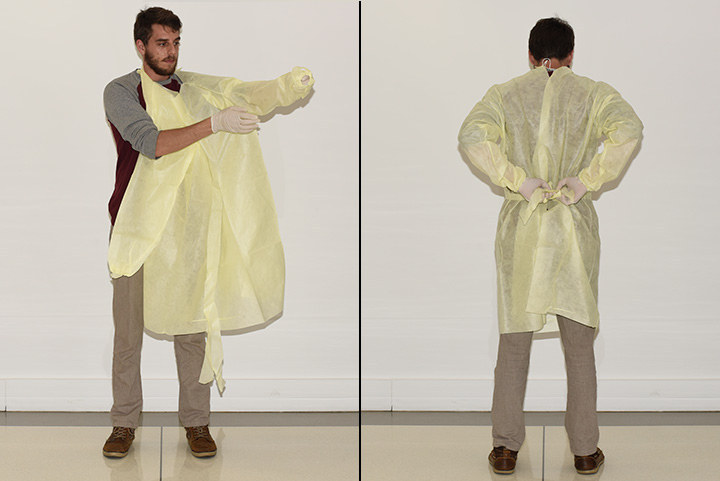
Step one is to put on the waterproof gown in the backward-bathrobe style of those glorified napkins they give patients to wear in the hospital. Make sure the gown covers from the neck to the knees, reaches all the way down to the wrists, and wraps around to tie securely in the back at the neck and waist. Do not, in your zeal for protection, tie impossible knots. You are going to have to untie these later. Remember that.
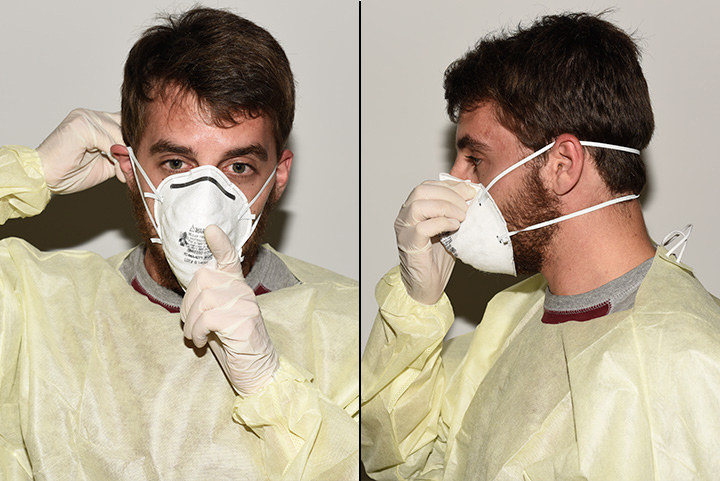
Next up is the surgical mask. Place it on your face and tie it securely around the back of your head and at the top of the neck. Then — and this is important — bend that little metal bit at the top edge of the mask to fit your nose. This is not something you can do later, as touching your face with contaminated hands defeats the entire purpose of suiting up. Make sure the mask covers you from up on the nose to below the chin and that it fits close to the face. Hope you brushed your teeth.
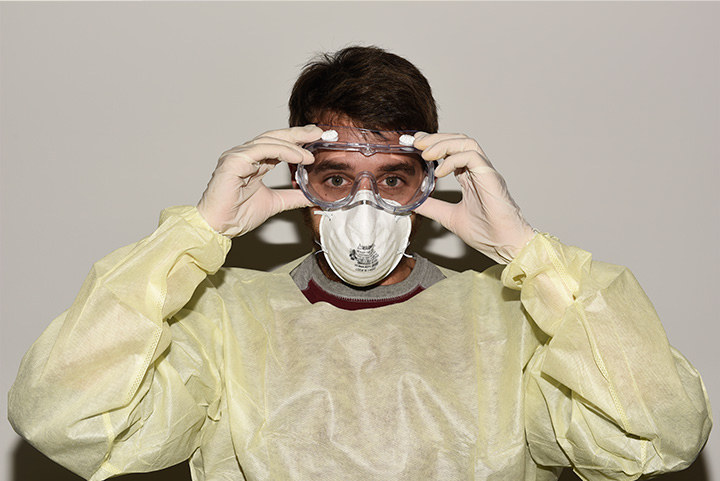
Once the mask is secured, pop those goggles on and adjust everything for a snug, perfect fit. Then check everything and adjust again. Make sure you haven’t screwed up your mask and then do another full recheck. Repeat as necessary. There will be no goggle-adjusting later, for obvious reasons. (Alternate option: Wear one of those “human windshield” face visors.)
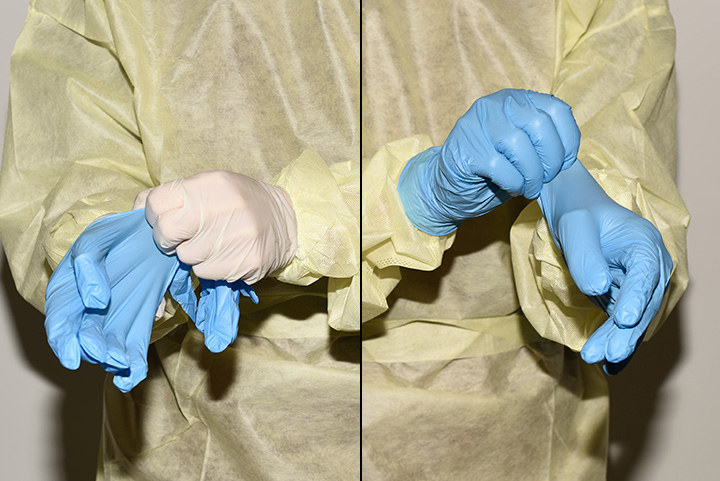
Last step is the gloves, which should be pulled up over the cuff of the gown. Be sure to tuck your sleeves into your gloves, and snugly. Sometimes people wear two pairs of gloves for additional protection — and easy replacement. Gloves must be replaced if they become too soiled, so double-bagging it means you can change them without untucking your sleeves and exposing yourself.
And you’re finished!
When wearing PPE, try to touch as few surfaces as possible and don’t mess with your gear. Fussing with things like ties, elastics, and fit at this point is verboten — you are going to have to touch some of those ties later, OK? They are precious and must remain pure.
Now comes the fun part. After baking in your protective cocoon, you get to peel that thing off. How you do this makes all the difference to successful PPE. Just like a great striptease, removing PPE is a deliberate act full of purpose, not a haphazard, utilitarian flailing. (It’s like the game The Floor Is Lava, but the outside of your PPE is the lava, and instead of lava, it’s Ebola.)
The first thing to go are the gloves. Do not — DO NOT — hook your finger inside the glove for removal. The way you would normally remove a glove — by sticking your fingers inside and pulling — would contaminate your “bare skin” glove. Instead, after a good rinse with some alcohol, pinch the outside of the glove with the opposite, still gloved hand, and then peel it off gently, letting it turn inside out during the process. You’ll wind up with a little wad of inside-out glove in the fingertips of your still-gloved hand; palm it and grip the shit out of it.
For the other hand, do not — DO NOT — do what you just did to the first glove and pinch the outside of it. You might want to because it’s how you took the first glove off, but your free hand is now inner-glove only. That means you can slip your finger into the clean interior of the remaining glove, hook it from the inside, and peel it off around the balled-up remains of its mate, creating a neat little dirty — and possibly biohazardous — glove bundle. Throw it away in the safe place you designated for biohazardous waste disposal.
To remove the gown safely, you must do so without touching the outside of it. Undo the ties in the back, and then, with your bare hands, reach down the front at the neck and push it away from your body from the inside; keep going until you turn the gown inside out, then fold it so the nasty is on the inside and roll it into a bundle for disposal, safe-side out. You can practice this technique with a Snuggie or other vaguely embarrassing blanket with arms.
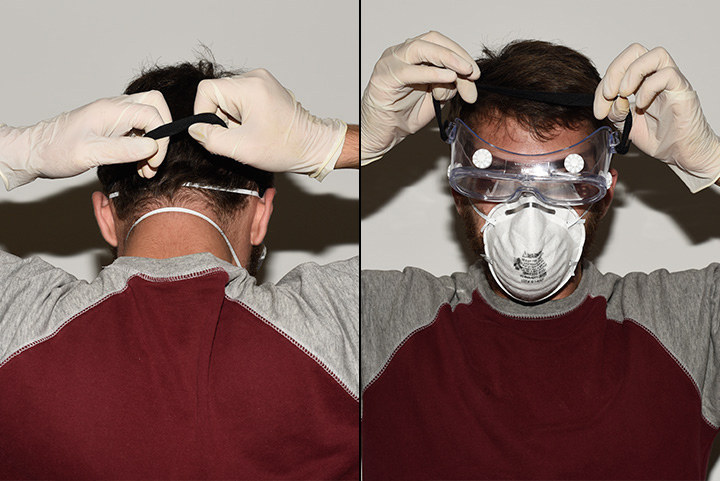
Now you can remove your goggles. Use your bare hands to touch only the strap on the back of your head. Do not touch the front of the goggles with your naked fingers. Gingerly drop that shit in the reprocessing bucket or the special trash. You’re almost free.
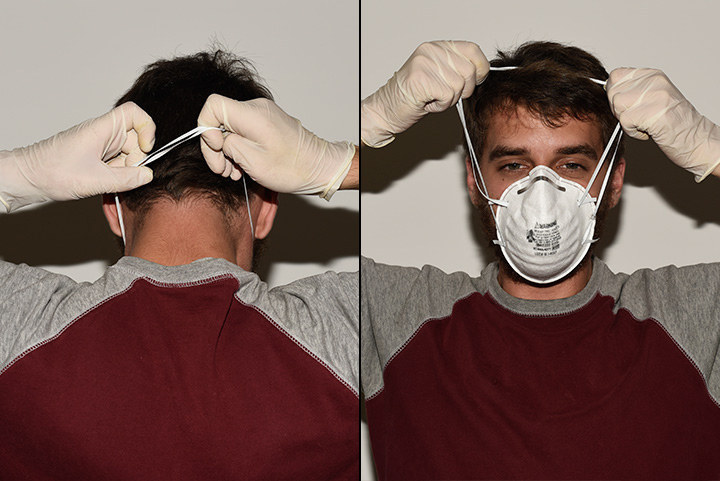
Next, you can take that disgusting mask off and feel something other than mouth breathing on your face. Untie the straps, touch nothing else, and gingerly remove it away from the body. Your chin will rejoice, finally free from the sauna of your stale, wet air.
Remove those inner gloves and you are fully doffed! Now wash your hands with alcohol-based hand sanitizer.
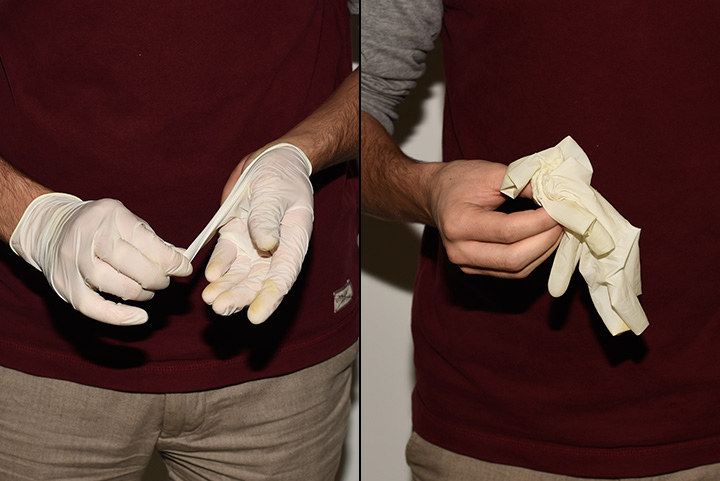
One last word of caution, though: Always be aware of your surroundings when dressing.
"I was in this cave in Uganda when bats were being captured for a necropsy,” said the CDC’s Manning, who often assists researchers in the field. He was helping trap and test bats to search for signs of Marburg virus, a lethal cousin of Ebola, and he was suited up to avoid exposure. “I mean, you've been in bat caves; they're just nasty places. They're slippery, they're dark, and you're easily off-balance. At a certain point, I had this searing, burning, stinging pain from the left corner of my left eye, under my face shield, while inside the cave.” He stayed calm but thought, Oh wow, things are going south really fast.
“I had this huge, huge desire to just take my gloved hand and reach it under the face shield and start rubbing the corner of my eye to figure out what might be in there flailing around,” he said via phone from his office in Atlanta. “But, of course, that’s a bad idea.”
Manning also realized that, in addition to the searing pain, the protective barrier of his Tyvek suit wasn’t quite so safe anymore. “The integrity of that barrier had kind of evaporated. I thought to myself, This can't be good.” So he carefully left the cave, and that’s when he put the clues together.
“I noticed that there were some red ants near to where I had been suiting up that morning. What I think might have happened is that the ant landed somehow on my skin and I went into the cave, didn't know it was there because it was so hot and smelly. By the time it'd found an area of mucosa by my eye, it started to bite, and that's what I was experiencing as a searing pain.”
Manning said, “Everybody on the team could tell you stories like that.” And with that, he burst into laughter.
